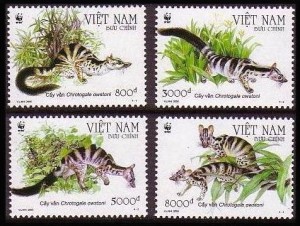Owston’s civet
Of all the small carnivores that scurry around the Annamite jungles one stands out as emblematic of the unique biodiversity of this region: Owston’s civet (Chrotogale owstoni). As I’ve mentioned in the post on the large Indian civet the viverrids are one of the most diverse and successful carnivore groups in Indochina. They come in a bewildering array of shapes and colors. But none are as visually stunning as Owston’s civet. For this Species Spotlight animal I want to start with a description because it is in my opinion one of the most elegant creatures to stalk these forests. Owston’s civet is a mid-sized civet, similar in size to a domestic housecat. It has a tawny buff gray body streaked with vertical black bands that dissolve into spots along the neck, shoulders, and legs. Like a tiger the stripes are unique on each side of the body. Three or four bands cover a long furry tail. The remainder is jet black. The striped face is unusually narrow and pointed: an evolutionary adaptation that allows the civet to snatch ground-dwelling invertebrates that may be nestled into the leaf litter on the forest floor. One would be hard-pressed to find a more striking member of the small carnivore guild.
Yes, it wears a beautiful fur coat—but what really makes Owston’s civet special from a conservation perspective is that it is only found in Laos, Vietnam, and a small part of southern China. Most of its global range lies within the Annamite Mountains. While other civet species found in this region range over large parts of Asia, Owston’s civet is, in large part, an Annamite species. And a poignant reminder of why the biodiversity in this region is so special. Although Owston’s civet was discovered by science almost 100 years ago biologists still know very little about its ecology. Like other small carnivores this secretive and nocturnal civet is difficult to study in the wild. Camera trapping studies have found it to be locally abundant in some parts of Vietnam. However, it is believed that intensive snaring and habitat loss throughout Vietnam and Laos have significantly reduced numbers. Unlike other Annamite species such as Saola and striped rabbit there is a successful captive breeding program for Owston’s civet. Healthy captive populations serve as a safeguard against extinction in their native habitat. That being said, it is my fervent hope that the species will be conserved in situ. This small carnivore is seldom seen or detected. Even so I feel that the Annamite jungles wouldn’t be the same without it.


